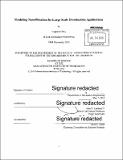| dc.contributor.advisor | John H. Lienhard, V. | en_US |
| dc.contributor.author | Roy, Yagnaseni | en_US |
| dc.contributor.other | Massachusetts Institute of Technology. Department of Mechanical Engineering. | en_US |
| dc.date.accessioned | 2015-12-03T20:53:13Z | |
| dc.date.available | 2015-12-03T20:53:13Z | |
| dc.date.copyright | 2015 | en_US |
| dc.date.issued | 2015 | en_US |
| dc.identifier.uri | http://hdl.handle.net/1721.1/100096 | |
| dc.description | Thesis: S.M., Massachusetts Institute of Technology, Department of Mechanical Engineering, 2015. | en_US |
| dc.description | Cataloged from PDF version of thesis. | en_US |
| dc.description | Includes bibliographical references (pages 91-94). | en_US |
| dc.description.abstract | The Donnan Steric Pore Model with dielectric exclusion (DSPM-DE) is implemented over flatsheet and spiral-wound leaves to develop a comprehensive model for nanofiltration modules. This model allows the user to gain insight into the physics of the nanofiltration process by allowing one to adjust and investigate effects of membrane charge, pore radius, and other membrane characteristics. The study shows how operating conditions such as feed flow rate and pressure affect the recovery ratio and solute rejection across the membrane. A comparison is made between the results for the flat-sheet and spiral-wound configurations. The comparison showed that for the spiral-wound leaf, the maximum values of transmembrane pressure, flux and velocity occur at the feed entrance (near the permeate exit), and the lowest value of these quantities are at the diametrically opposite corner. This is in contrast to the flat-sheet leaf, where all the quantities vary only in the feed flow direction. However it is found that the extent of variation of these quantities along the permeate flow direction in the spiral-wound membrane is negligibly small in most cases. Also, for identical geometries and operating conditions, the flatsheet and spiral-wound configurations give similar results. Thus the computationally expensive and complex spiral-wound model can be replaced by the flat-sheet model for a variety of purposes. In addition, the model was utilized to predict the performance of a seawater nanofiltration system which has been validated with the data obtained from a large-scale seawater desalination plant, thereby establishing a reliable model for desalination using nanofiltration. | en_US |
| dc.description.statementofresponsibility | by Yagnaseni Roy. | en_US |
| dc.format.extent | 94 pages | en_US |
| dc.language.iso | eng | en_US |
| dc.publisher | Massachusetts Institute of Technology | en_US |
| dc.rights | M.I.T. theses are protected by copyright. They may be viewed from this source for any purpose, but reproduction or distribution in any format is prohibited without written permission. See provided URL for inquiries about permission. | en_US |
| dc.rights.uri | http://dspace.mit.edu/handle/1721.1/7582 | en_US |
| dc.subject | Mechanical Engineering. | en_US |
| dc.title | Modeling nanofiltration for large scale desalination applications | en_US |
| dc.type | Thesis | en_US |
| dc.description.degree | S.M. | en_US |
| dc.contributor.department | Massachusetts Institute of Technology. Department of Mechanical Engineering | |
| dc.identifier.oclc | 929072254 | en_US |
